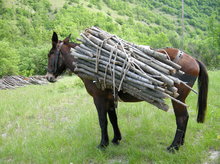A new report from the worldâs largest international equine welfare charity, the Brooke, found that the contribution of working horses, donkeys, and mules to the livelihoods of some of the worldâs poorest people is overlooked, leaving working equines invisible in livestock policy and suffering as a result.

A donkey with a heavy workload
Itâs easy to forget that horses once provided a great deal of labor to every-day people. For 600 million people in the developing world today that is still the reality - 112 million horses, donkeys, and mules are supporting their livelihoods.
âInvisible Workers,â released today, presents evidence showing how working horses, donkeys, and mules around the world enable their owners to earn money, to feed, clothe, and educate their families.
These animals work in many areas including construction, agriculture and public transportation. Many of them work every day, with inadequate access to food or water, and suffering from wounds, disease and lameness.
Livestock policy and international development programs exist to make sure that owners can properly care for the animals that contribute to their livelihoods. However, currently the animals included in these policies and programs are limited to the ones that directly produce food or fabrics, like cows, chickens and goats.
Despite the massive contribution working equines make, theyâre not considered âcriticalâ livestock. The Brooke wants this to change.
Petra Ingram, Chief Executive of the Brooke said, âIn the industrialized world as in the US, itâs easy to forget that horses once provided a great deal of labor to every-day people. For 600 million people in the developing world today that is still the reality - 112 million horses, donkeys, and mules are supporting their livelihoods.
If people lose those animals because they donât have access to welfare resources like vaccinations and health programs, the impact can be devastating.
âWorking animals are the invisible powerhouses of the developing world. We want all policy makers to properly recognize the important role they play in supporting the lives of their owners.â
The Brooke is holding an event today to bring together influential partners including the World Organization for Animal Health and The Food and Agriculture Organization of the UN, to discuss the next steps to getting these animals recognized on the world food security agenda.
The Brooke is the worldâs largest international equine welfare charity. For more than 80 years the Brooke has been dedicated to improving the lives of working horses, donkeys and mules in the worldâs poorest communities.
Evidence-based research has proven that animal suffering is preventable and that good animal welfare protects human livelihoods. 112 million working equines are the engines that power the developing world, doing the hardest jobs under the toughest conditions to support the livelihoods of 600 million people. Thatâs 9% of the worldâs population.
The Brooke works with owners, communities and policy makers to bring about lasting improvements to the lives of working animals. Operating in 11 different countries, and funding projects in 4 others, the Brooke now reaches more than 1.8 million working horses, donkeys, and mules â more than any other organization.
It is on target to reach two million working equines each year by 2016. The American affiliate, Brooke USA, is headquartered at the Kentucky Horse Park in Lexington and exists to support the overseas work of the Brooke.
To read the report, go to http://www.brookeusa.org/invisible-workers-report or contact Cindy Rullman, Brooke USA, 859-296-0037 or Cindy.Rullman@BrookeUSA.org. To learn more about the mission of the Brooke, go to www.BrookeUSA.org.
